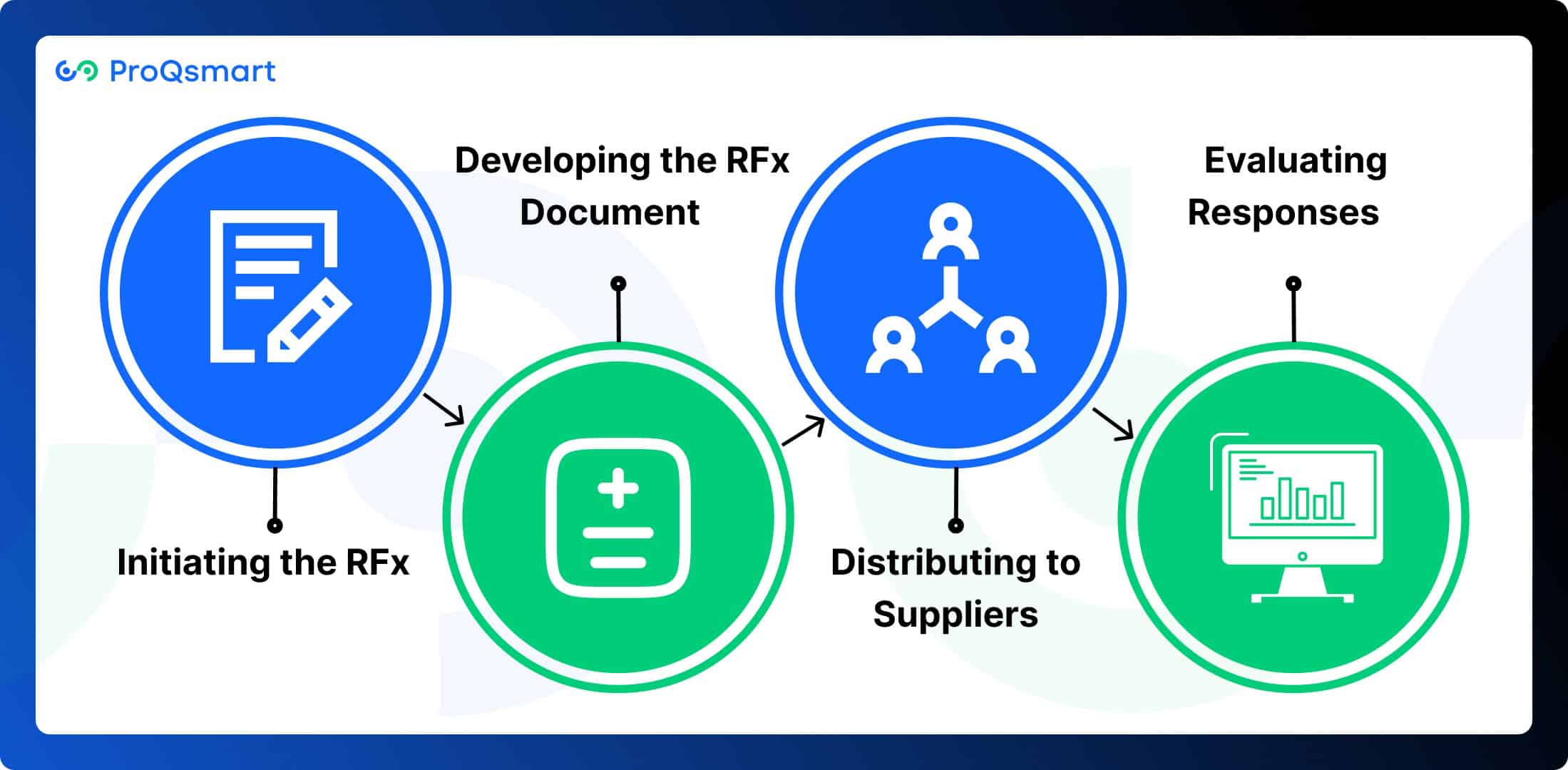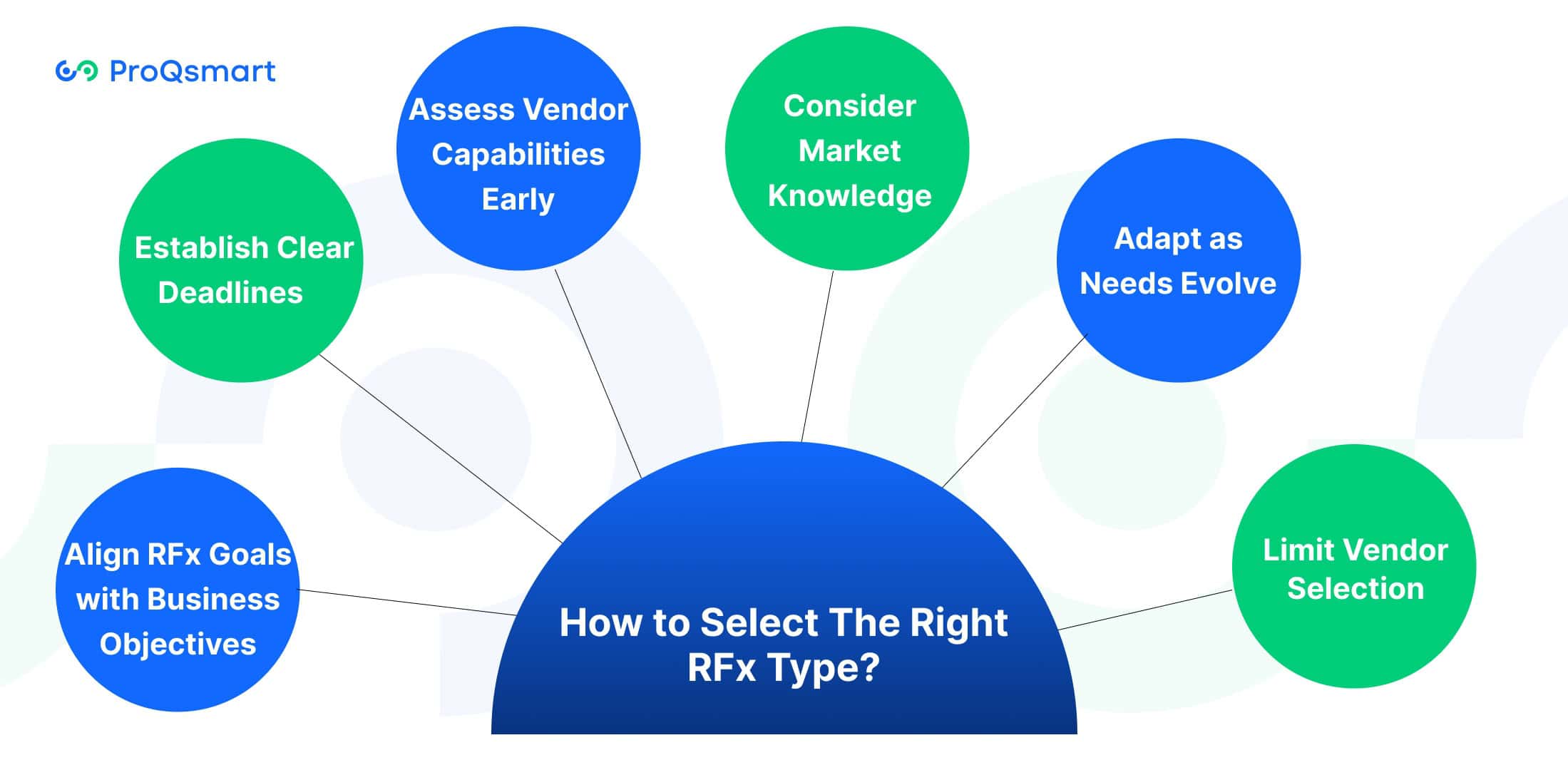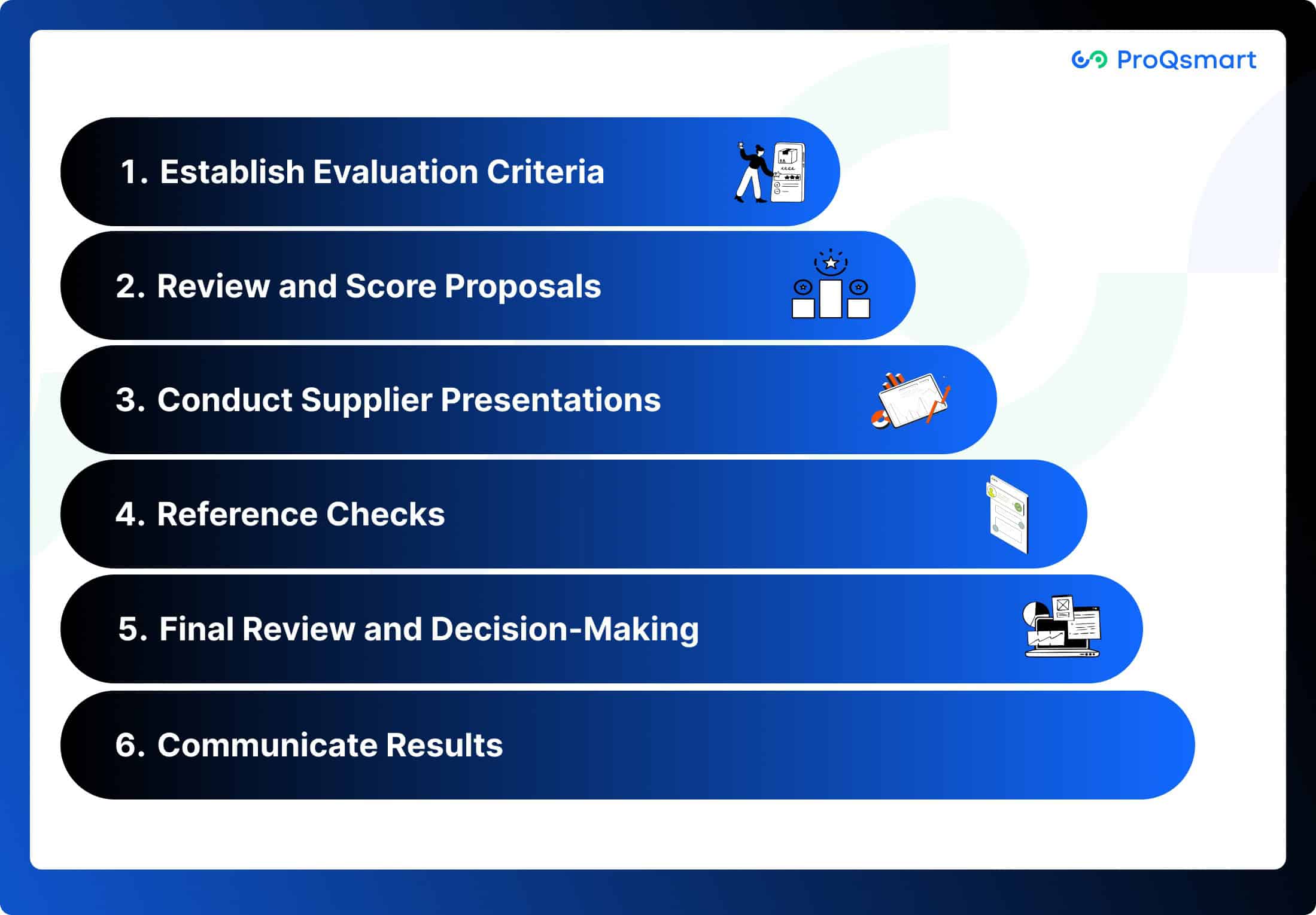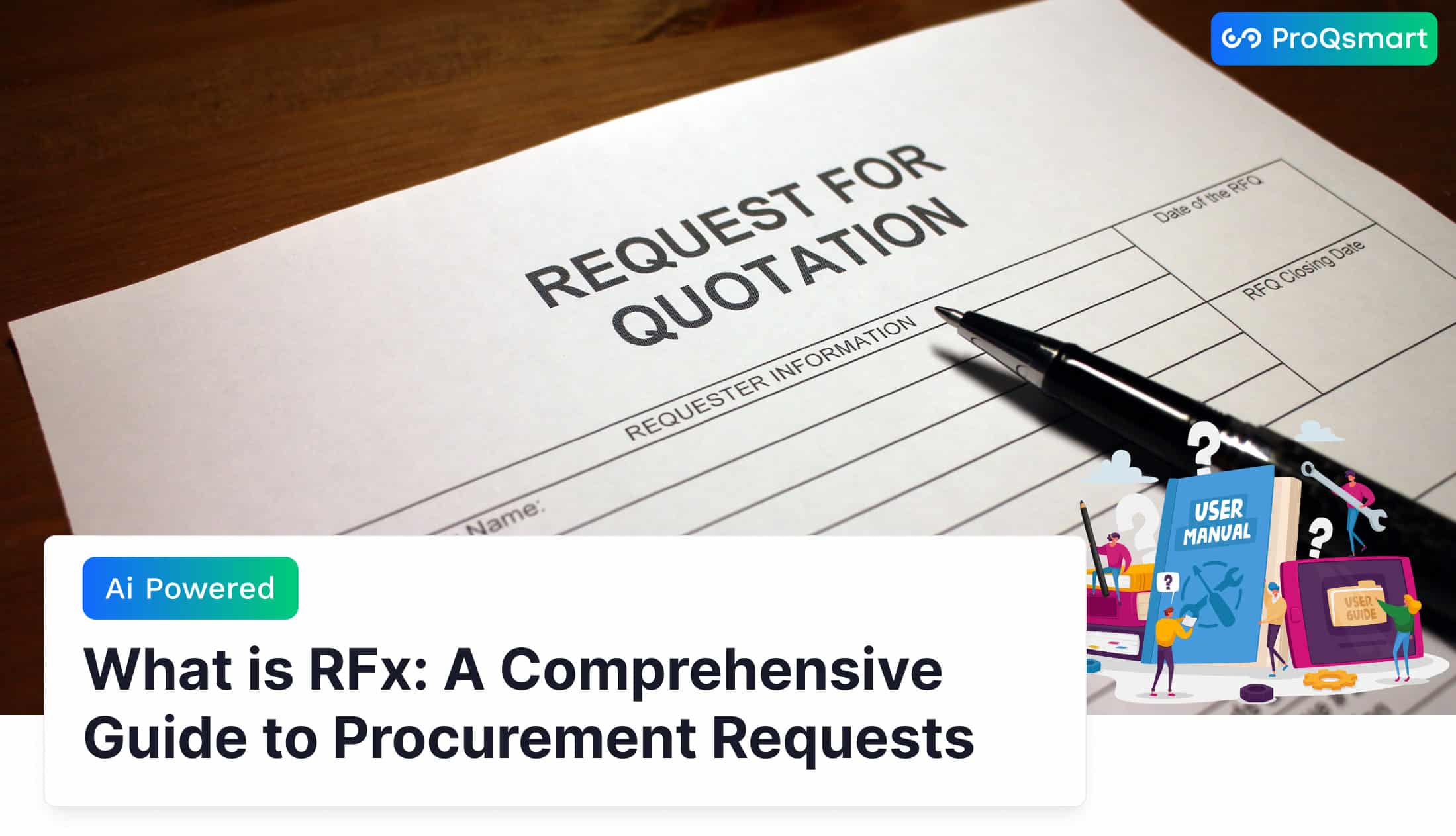RFx, which stands for “Request for x,” includes various formal requests used in procurement. Each of these tools serves a specific purpose, making the procurement process more efficient and straightforward.
To choose the right RFx type, it’s important to understand their functions. Use an RFP when you need detailed proposals to address specific project needs. An RFQ is appropriate for obtaining price quotes on clearly defined products or services, while an RFI is useful for gathering general information about suppliers or market conditions.
Selecting the right RFx can enhance your procurement strategy by streamlining supplier selection and improving outcomes. Additionally, leveraging procurement software can simplify the management of these requests, helping you track responses and stay organized.
What is RFx in Procurement?
RFx stands for “Request for X,” where “X” represents various types of procurement requests, such as Requests for Information (RFI), Requests for Proposals (RFP), and Requests for Quotations (RFQ). This term serves as an umbrella for all formal requests made during the procurement process, allowing organizations to communicate their needs to potential suppliers clearly.
The RFx process enables companies to gather essential information, compare options, and secure the best prices for their requirements. By following a structured approach, organizations can make informed decisions that align with their goals and budgets.
How RFx Impacts on Procurement Process
Simplifies Information Gathering: RFx processes streamline the collection of vendor proposals, quotes, or information, reducing the time spent searching for suppliers and pricing.
Improves Clarity: By clearly stating specifications and expectations, RFx helps vendors understand what is required, aligning their offerings with the organization’s needs.
Facilitates Comparison: With all vendor responses organized in one place, it becomes easier to compare offers based on price, quality, and delivery timelines.
Enhances Decision-Making: The structured nature of RFx allows procurement teams to evaluate proposals systematically, ensuring that selections are based on comprehensive market information.
Supports Strategic Sourcing: Utilizing RFx tools enables organizations to engage in strategic sourcing, fostering competition among vendors and leading to better value for money.
Steps Involved in the RFx Process

1. Initiating the RFx
The RFx process begins with a clear understanding of your objectives. Defining your goals is crucial—whether you aim for cost savings, improved quality, or establishing new supplier relationships. This clarity helps maintain focus and guides decision-making throughout the process.
Next, identify potential vendors to engage. Conduct thorough research on their past performance, check reviews, and consider reaching out to new suppliers in addition to established contacts. Clear communication from the outset is essential; articulate what you want and why it matters to ensure everyone is aligned.
Finally, create a list of must-haves. This outlines specific requirements from your vendors, minimizing confusion later on.
2. Developing the RFx Document
Once you have defined your objectives and requirements, it’s time to compile the RFx document. Think of this document as a blueprint for your procurement needs. Structure it clearly using headings, bullet points, and straightforward language to enhance readability. This organized approach aligns with effective proposal management practices and facilitates a smooth submission process.
Collaboration is key during this phase. Involving team members from various departments ensures that the document is comprehensive and aligns with your organization’s goals. Engaging different stakeholders also strengthens the negotiation phase, leading to better procurement outcomes.
A well-crafted RFx document not only streamlines vendor selection but also serves as a strategic tool for future procurement projects. By focusing on clear definitions and effective communication, you can create a document that meets both your business needs and those of prospective vendors.
3. Distributing to Suppliers
With your RFx documents ready, distribute them widely using digital platforms to maximize your sourcing efforts. Sharing the documents with a broad pool of prospective vendors increases the likelihood of finding the right fit for your procurement needs.
To ensure suppliers know what to expect, consider hosting a Q&A session or creating a comprehensive FAQ document. Effective communication management is crucial; log questions and provide uniform updates to avoid confusion during the RFx process.
This transparency fosters trust and encourages participation from suppliers.Incorporating a structured RFx workflow can streamline vendor selection and enhance procurement efficiency. By utilizing various RFx tools, you can manage vendor responses effectively and optimize your overall procurement strategy.
4. Evaluating Responses
The evaluation phase is critical for ensuring fairness and transparency. Begin by establishing a vetting process for vendor responses based on the evaluation criteria set earlier. This framework allows for objective assessments of each response.Implementing scoring systems can help quantify how vendors compare against one another.
As you evaluate submissions, maintain transparency by documenting decisions and keeping stakeholders informed throughout the process. This approach builds trust and accountability among all parties involved.
How to Select The Right RFx Type?

In the procurement process, choosing the appropriate RFx type is essential for achieving successful out comes. Here are key factors to consider:
Align RFx Goals with Business Objectives: Ensure that your RFx goals are in line with your overall business objectives. For example, if you are a construction company looking for building materials, an RFQ would be suitable to obtain competitive pricing.
Evaluate Project Complexity: Assess the complexity of your project when determining the RFx type. If your needs are straightforward, an RFQ may suffice. However, for more complex projects, such as constructing a new facility or implementing a comprehensive software system, an RFP would be more appropriate to solicit detailed proposals.
Assess Vendor Capabilities Early: Evaluate potential vendors at the outset of the RFx process. Understanding their capabilities will help you identify suppliers who can meet your specific requirements effectively.
Consider Market Knowledge: If you lack familiarity with the market or available suppliers, starting with an RFI can provide valuable insights into potential vendors and their offerings. This step can inform your subsequent RFP or RFQ.
Adapt as Needs Evolve: Be prepared to adjust your RFx type as your procurement needs change. If you require more comprehensive solutions, transitioning from an RFQ to an RFP or RFI may be necessary.
Limit Vendor Selection: To enhance the quality of responses and streamline negotiations, consider limiting your vendor selection to three to six suppliers. This focused approach improves the negotiation process for both parties and allows for more meaningful discussions.
Tips to Write an Effective RFx
Key Elements to Include
When crafting an RFx document, think of it as a transparent map for vendors. It is essential to include all the necessary components to ensure clarity and effectiveness. A well-defined RFx should feature:
Clearly Defined Scope of Work: Outline the specific tasks, deliverables, and objectives expected from the vendor.
Detailed Project Requirements: Include comprehensive specifications that vendors need to meet.
Timeline: Establish a timeline that aligns with all stakeholders’ expectations, ensuring everyone is on the same page.
A structured RFx process resembles a well-organized book; it should be easy to read and navigate. Utilizing headings and subheadings can help guide readers through the document seamlessly. Additionally, incorporating tools like ProQsmart can enhance the proposal management experience, streamline vendor selection, and improve overall procurement efficiency.Providing clear instructions on how vendors should submit their proposals is crucial to prevent confusion and ensure that everyone understands the requirements.
Common Mistakes to Avoid While Crafting RFx
While drafting your RFx, be aware of common pitfalls that can hinder the process:
Vagueness in Requirements: One of the most significant mistakes is being unclear about your needs. If your requirements are ambiguous, vendors may struggle to provide suitable proposals, leading to unnecessary back-and-forth communication and potential project delays.
Insufficient Time in the RFI Phase: Many procurement managers report not spending enough time during the RFI phase, resulting in vague instructions. It’s vital to invest time upfront to gather accurate information; incorrect data will lead to incorrect outcomes.
Neglecting Thorough Review: Before distributing your RFx, conduct a comprehensive review of the document. This step helps identify any mistakes or unclear sections that could lead to misunderstandings with suppliers. Miscommunication can result in costly errors down the line.
Failing to Convey Clear Expectations: It’s essential to clearly communicate how vendors should submit their proposals and what criteria will be used for evaluation. Lack of clarity in submission guidelines can lead to confusion among suppliers, resulting in incomplete or irrelevant proposals.
Evaluating RFx Proposals

The evaluation of RFx proposals is a critical phase in the procurement process, as it determines which vendor will be selected to fulfill your organization’s needs. This process requires a structured approach to ensure fairness, transparency, and alignment with project objectives. Below, we outline the essential steps and considerations for effectively evaluating RFx proposals.
1. Establish Evaluation Criteria
Before the RFx is released, it is crucial to define clear evaluation criteria that will guide the assessment of vendor proposals. These criteria should reflect the specific needs of your project and can include factors such as:
Cost: The total price proposed by each vendor.
Quality: Assessment of the proposed solutions against established quality standards.
Technical Capabilities: Evaluation of the vendor’s ability to meet technical specifications.
Experience and Reputation: Consideration of the vendor’s past performance and references.
Compliance: Adherence to mandatory requirements outlined in the RFx.
By establishing these criteria upfront, you create a standardized framework that helps eliminate subjectivity during the evaluation process.
2. Review and Score Proposals
Once proposals are submitted, begin the review process by scoring each response against the predefined criteria. This step may involve:
Individual Assessments: Each evaluator reviews proposals independently to provide an initial score based on their expertise.
Weighted Scoring: Assign different weights to various criteria based on their importance to the project. For instance, if technical capabilities are paramount, they might carry a higher weight than cost.
Utilizing a scoring matrix can facilitate side-by-side comparisons of vendor responses, making it easier to identify strengths and weaknesses across proposals.
3. Conduct Supplier Presentations
In more complex procurement scenarios, it may be beneficial to invite top vendors for presentations or demonstrations. This allows your team to:
Clarify Questions: Address any ambiguities in proposals directly with vendors.
Assess Fit: Evaluate how well vendors understand your requirements and their capacity to deliver solutions that align with your objectives.
These interactions can provide valuable insights that go beyond what is presented in written proposals.
4. Reference Checks
Conducting reference checks is another vital step in the evaluation process. Reach out to previous clients of the vendors to gather feedback on their performance, reliability, and overall satisfaction. This information can help validate claims made in proposals and provide additional context for decision-making.
5. Final Review and Decision-Making
After scoring proposals and conducting reference checks, convene your evaluation team to discuss findings. During this meeting:
Compare Scores: Review the scores assigned to each proposal and discuss any discrepancies among evaluators.
Consider Qualitative Factors: Beyond numerical scores, consider qualitative aspects such as vendor culture fit or innovative approaches presented in their proposals.
Ultimately, aim for a consensus on which vendor best meets your project requirements while aligning with your organization’s goals.
6. Communicate Results
Once a decision has been made, communicate the results transparently to all participating vendors. Provide constructive feedback where possible, especially to those who were not selected. This practice fosters goodwill and encourages future participation in your procurement processes.
Best Practices for RFx Management
Effective RFx management is crucial for streamlining the procurement process and ensuring successful vendor selection. By implementing best practices, organizations can enhance efficiency, reduce costs, and build stronger relationships with suppliers. Below are key strategies to optimize your RFx management.
Streamlining the RFx Process
Efficiency is paramount in the RFx process. One effective way to streamline operations is by limiting the number of vendors to three to six. This approach not only keeps the selection process equitable but also prevents overwhelming your team with too many options. By focusing on a select group of vendors that closely align with your needs, you can make more informed decisions without getting lost in a multitude of proposals.
Automation is another vital component of streamlining the RFx process. By automating repetitive tasks such as data entry and communication, you can centralize these processes and minimize human errors. This centralization not only shortens purchase cycles but also enhances the accuracy of information exchanged between your organization and vendors. With fewer mistakes, decision-making becomes more straightforward, allowing you to assess risks effectively.
Moreover, efficient processes foster better relationships with vendors. When you operate clearly and efficiently, suppliers are more likely to want to collaborate with you. They appreciate working with organizations that respect their time and demonstrate professionalism throughout the procurement process.
Leveraging Technology and Tools
In today’s digital age, leveraging technology for RFx management is essential. Various software solutions can significantly ease the burden of managing RFx processes. For instance, utilizing a centralized platform for RFx management helps ensure that all stakeholders are aligned, facilitating seamless collaboration and mitigating risks.
E-procurement software such as ProQsmart simplifies data collection and analysis, allowing you to set scoring thresholds for vendor responses. This ensures that evaluations are consistent and objective—critical factors for a successful RFP process. Furthermore, consider implementing short-form RFPs that utilize as few as ten questions; this approach not only lightens your workload but also reduces the burden on prospective vendors, leading to more efficient negotiations. Additionally, technology can validate supplier information provided in their RFP responses. By leveraging external intelligence resources, you can cross-check details and reduce risks associated with vendor selection. This capability enables quicker and more accurate decision-making.
Final Remarks
In conclusion, effective RFx management is essential for optimizing procurement processes and ensuring successful vendor selection. By implementing best practices such as streamlining operations, leveraging technology, establishing clear communication channels, and conducting thorough evaluations, organizations can enhance efficiency and build stronger relationships with suppliers.
As the procurement landscape continues to evolve, utilizing advanced RFx management tools like ProQsmart can significantly improve your workflow. ProQsmart offers a centralized platform that automates many aspects of the RFx process, allowing you to focus on strategic decision-making rather than administrative tasks.
If you’re ready to transform your RFx management and drive better procurement outcomes, book a demo with ProQsmart today. Experience firsthand how this innovative solution can streamline your processes and enhance collaboration with vendors, ultimately leading to more successful project implementations. Don’t miss the opportunity to elevate your procurement strategy—schedule your demo now!
FAQs
What is RFx in Procurement?
This is known as RFx, where x represents various requests such as quote, bid, tender, and others. The “X” stands for Request for Proposal (RFP), Request for Quotation (RFQ), or Request for Information (RFI), serving as a strategic sourcing method to extract specifics from suppliers.
What are the Types of RFx Documents?
RFx documents encompass various requests such as RFP (Request for Proposal), RFQ (Request for Quotation), and RFI (Request for Information), each with distinct rfx definitions that play crucial roles in the procurement process.
How Do RFx Types Differ?
RFPs, RFIs, and RFQs serve distinct purposes in the procurement world; understanding the rfx definitions helps you choose the right document to suit your business needs effectively.
What are the Steps in the RFx Process?
You start with the business requirements document, then write the RFx definition, circulate it, collect vendor responses, score the proposals, and select a supplier. Each step is critical for successful procurement.
How Do You Select the Right RFx Type?
Select based on your requirements, utilizing different RFX tools effectively. You would use an RFI to gather information, an RFQ to obtain pricing, and an RFP to secure more formal proposals. Once you understand your objectives, the RFX processes simplify the decision-making.
How Can You Write an Effective RFx?
Be direct to the point by utilizing effective RFx definitions. Clearly define your needs, deadlines, and how you will evaluate submissions, ensuring suppliers understand your requirements and can respond accordingly. You can use procurement software like ProQsmart to ease the process.



